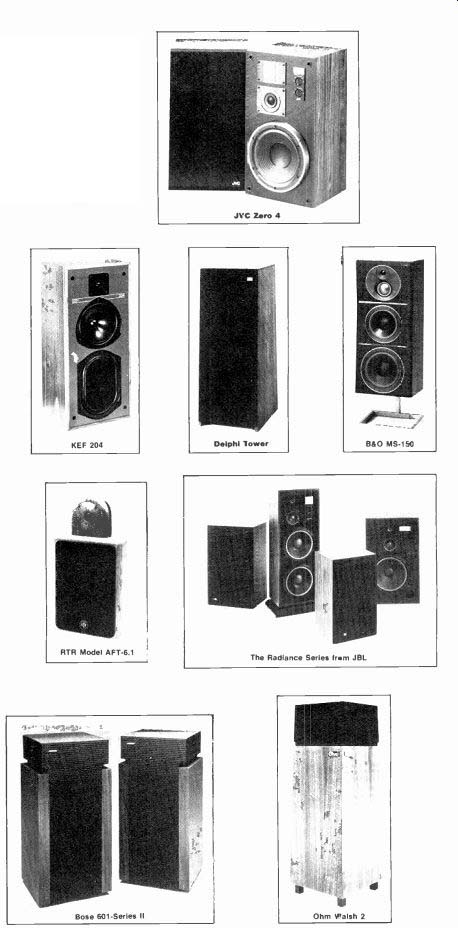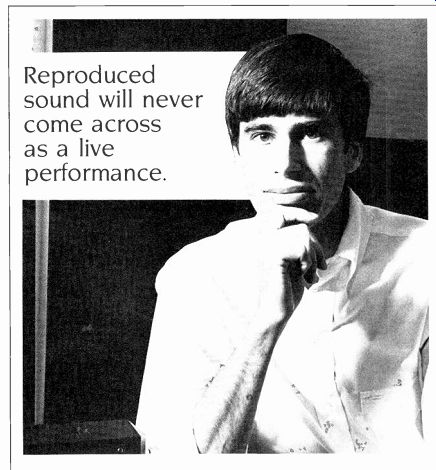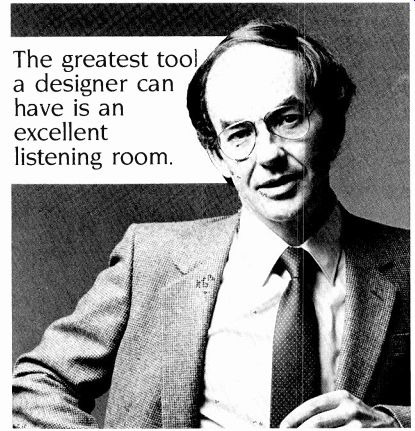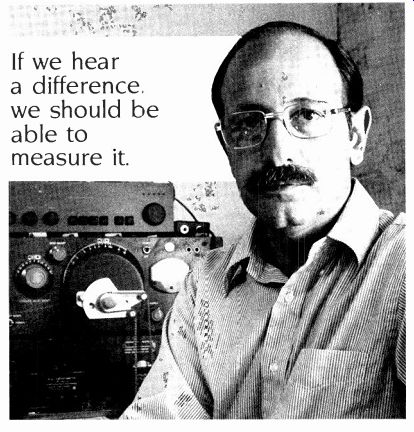1982 Speaker Designs: Closer to Perfection?-- A look at 100 new speakers; plus, how four speaker designers view their work.
A comprehensive survey of brand-new models, plus interviews with four speaker designers on the future of their art.
by Michael Riggs and Peter Dobbin
IF YOU'RE SPEAKER SHOPPING this fall, what you'll be seeing, by and large, are lots of practical, down-to-earth designs whose appeal (quite rightly) rests on improvements in performance rather than on flashy or novel techniques. Indeed, it seems that the ordinary dynamic loud speaker will remain the choice of the vast majority of music listeners for quite some time to come. These seldom-glamorous speakers are reliable, easy to manufacture, and-after the last five years of intensive development--really quite good by any standard.
This is not to dismiss nondynamic loudspeaker systems as mere also-rans.
In fact, much attention is being lavished on Quad's ESL-63 electrostatic loud speaker ($3,300 per pair) which joins the company's first (and until now only) speaker. While retaining the smooth, de tailed midrange that made the twenty three-year-old original famous, the new system provides extended bass response, higher maximum output, and built-in overload protection to prevent destruction of the electrostatic panel by the overenthusiastic application of power.
The ESL-63's most novel feature, however, is its use of concentric rings of electrodes, fed from sequential signal-delay lines, to drive the diaphragm. Quad says that careful timing of the delays yields a sonic effect analogous to what one sees when a stone is dropped into still water; the sound seems to radiate from a single, phase-coherent point source behind the plane of the diaphragm.
Acoustat also has a new full-range electrostatic speaker. The Model Four ($2,000 per pair) is reported to have the widest frequency response and dispersion, highest sensitivity, and greatest maximum output level of the speakers now in the company's Slimline Series.
And RTR, which has long manufactured electrostatic tweeter arrays, now has an almost-full-range model, dubbed the ESR-24 ($1,500), whose rated-3-dB points are at 132 Hz and 35 kHz.
RTR also offers a new subwoofer, the DAC-2, with two 8-inch woofers and a 15-inch passive radiator, and a small two-way speaker called the AFT-6.I ($330), which employs a 6-inch woofer and a 1-inch dome tweeter. The unusual tweeter is made of super-strong Kevlar fibers applied in a specific geometric pat tern on the surface of a soft plastic dome.
RTR says that this enables the speaker to operate as a piston up to 40 kHz, in stead of starting to break up between 10 and 20 kHz, as do most other tweeters.
Magnepan has added one system to its line of non-electrostatic planar-magnetic loudspeakers, and updates two more. The improved members of the family are the MG-2B ($950 per pair) and MG-1A ($625 per pair), and the baby is the SMG ($405 per pair). Similar in spirit, if somewhat different in price and execution, is the Jumetite Laboratories CR-610 ($3,500 per pair), which uses a horn-loaded ribbon tweeter above 600 Hz and two 10-inch dynamic woofers below. The manufacturer says that the low mass of the ribbon tweeter pro vides excellent transient response. The last word in low-mass drivers, the Dahlquist-Magnat Corona-Plasma tweeter ($1,000), uses a cloud of ionized air as its diaphragm. The device, said to be a perfect omnidirectional point source, will be distributed in the U.S. by Dahlquist, Inc. A company spokesman tells us that they plan to incorporate the Corona-Plasma tweeter in a full-range system.
Yet, as we said, the traditional dynamic loudspeaker provides the bulk of the season's new offerings. Indicative of the refinements being lavished on the genre is a new speaker in Sony's high-end Esprit series that uses a flat APM (accurate piston motion) woofer and a tweeter in an oval cabinet for minimum diffraction. Each APM-6 Monitor costs $5,000.
No less unusual in shape but far more affordable ($385) is Shahinian Acoustics' Arch-a modified wedge shaped trapezoid with sides that extend to a floor-standing base. The cabinet configuration and its internal bracing are intended to eliminate or reduce most internal standing waves. Drivers include an 8-inch polypropylene woofer, a 2-inch midrange dome, a 1/4-inch dome tweeter, and a 3/8-inch dome super- tweeter. Other new items in the Shahinian line include the three-way Pipe loudspeaker ($235) and a tube electronic crossover ($1,150) for the Contra Bombarde subwoofer ($1,250), which is now in production.
Two other small American manufacturers have extensively redesigned lines. Fulton offers the 80B ($250) and Nuance ($750) speakers and the latest version of the top-of-the-line Premiere ($5,500 per pair). Fried's loud speakers range from the Q/2 ($350 per pair), with a new polypropylene woofer, to the pyramidal HPS ($3,000 per pair), with a 12-inch woofer, a 3-inch dome midrange, and a dome tweeter.
Vandersteen's Model 3 ($1,900 per pair) is an enhanced version of its al ready established Model 2B, with a ribbon (instead of a dome) tweeter and a built-in subwoofer. Infinity, on the other hand, offers a scaled-down version of its Reference Standard II called, not surprisingly, the Reference Standard III. At $450, it includes two 8-inch Watkins dual-drive woofers with polypropylene cones, a 5-inch polypropylene midrange, and an Emit tweeter.
Thiel has improved its Model 04 speaker and renamed it the Model 04a ($570 per pair), and Polk Audio has a new edition of its top-of-the-line RTA 12. The RTA-12B ($500) features a redesigned cabinet, new drivers, and a new crossover network. Both systems are de signed for flat frequency response and phase coherence.
Also in the time-aligned camp is 3D Acoustics' new system. the Crescendo ($750 per pair). This handsome floor-standing unit incorporates an 8-inch woofer, a 5 1/2-inch midrange. and a 1-inch dome tweeter, with the two smaller drivers vertically aligned above the woofer and surrounded by beveled acoustic foam for smoother frequency response due to reduced sound diffraction.
Similar concerns, differently ex pressed, are embodied in Ohm's Walsh 2 loudspeaker ($275), which uses a new version of the novel cylindrically radiating Walsh driver introduced in the early Seventies in the Ohm A. In this latest incarnation, the driver is modified to reduce production costs and to project sound over 180 degrees, rather than 360.
Though often less glamorous than competitive wares, introductions from Acoustic Research are always of interest ...
------------

Eleven New Affordable Designs
RTR Mode AFT-6.1, Bose 601-Series II, JVC Zero 4, Delphi lower, The Radiance Series from JBL, B60 MS-150
--------------
-----------
Reproduced sound will never come across as a live performance.
Matthew Polk--The Aesthetic Challenge

A graduate of Johns Hopkins (class of '71), Matthew Polk joined forces with two other Hopkins alumni in 1972 to form Polk Audio (initial investment, $200). In Polk's estimation, loud speaker designers are faced with an insurmountable problem if they posit as their goal the replication of live sound. "Reproduced sound will never come across as a live performance. Throughout the recording and record-mastering process, producers and engineers are twirling dials and making decisions about what sounds best. The loudspeaker designer there fore must make a product that can accurately represent that recorded material--not the live performance--and hope further that the consumer's sys tem will not degrade things." And though Polk has a well-stocked laboratory complete with sophisticated computers, he believes that such tools "can only get the designer into the ballpark, for no one has ever found a way of representing strong emotions mathematically. The truly difficult stage of loudspeaker design comes when we sit down to listen to the prototype. In fact, taking into account the countless adjustments and modifications made to prototypes as are salt of listening, loudspeaker design can still be considered a cut-and-paste operation." Polk feels strongly that in one major respect American loudspeaker manufacturers have followed an in correct course over the past decade by refusing to learn from where they've been. "Model changes have come so quickly that any advantage gained by research into previous models has been thrown away. In running counter to this, the British have taught us a great deal. They are quite careful about the direction of their research, making progress and developing concepts as fully as possible before committing them to new models." Finally, Polk believes that a loudspeaker will echo the personality of its designer more closely than any other component. "A designer who does not know himself is not likely to produce a good loudspeaker. He has to be able to feel all those emotional qualities of music. Without that, he's merely a technician. And, though he should feel free enough to admit that his taste-and therefore his designs will change over time, his work must show a sense of consistency and integrity."
-P.D.
----------------------
... to the audiophile. AR's latest, the three way Model 48s ($200), tops the Super Value bookshelf line. It has a 10-inch woofer, a new 4-inch midrange, and a 1-inch dome tweeter.
A pair of British manufacturers, KEF and Celestion, have two new speakers each. KEF's floor-standing Model 204 ($550) uses a 1-inch dome tweeter, a Bextrene cone woofer, and a flat passive radiator; the compact Model 203 ($300) houses the same woofer and tweeter in a smaller box and omits the passive radiator. Both of Celestion's en tries are two-way acoustic suspension de signs, with a 1-inch tweeter vertically aligned and flush-mounted above an 8-inch woofer (in the case of the Ditton 110, $350 per pair), or a 6 1/2-inch woofer (in the Ditton 100, $260 per pair).
Rogers' three-way ported loud speaker, the Studio 1 ($525), is said to be designed for low coloration and high power-handling capacity. The Linn Sara (small acoustical reproduction apparatus) loudspeaker is a two-way system.
Like Linn's larger DMS speaker, it uses Isobarik woofer loading, in which a second woofer within the sealed enclosure maintains constant pressure in the cavity between itself and the normally mounted woofer, reportedly extending the low end and reducing distortion.
JR's offerings represent a departure from its usual practice: They are rectangular boxes, rather than cylinders.
The larger of the two, the Magna ($565 per pair), incorporates a 1-inch tweeter and a 7-inch woofer, while the smaller Metro ($435 per pair), which is aimed at the minispeaker market, substitutes a 6-inch woofer.
The ARC-101 ($850) and the ARC-202 ($1,400) from ARC are two-way de signs that can be biamplified or driven in the usual way through a plug-in passive crossover. Boothroyd Stuart's Meridian M-3 is a scaled-down version of the M-2, with a single 5-inch woofer and a 1 1/4-inch dome tweeter driven individually via built-in amplifiers.
IMF has added speakers to the top and bottom of its range. The new flag ship, the Special Application Control Monitor, or SACM ($5,000 per pair), is a four-way system with the woofer and midrange drivers mounted in individual transmission lines and the tweeter and supertweeter in free space atop the wedge-shaped midrange enclosure. The much smaller MCR-2 ($500 per pair) is a two-way model built around the mid range and tweeter drivers found in IMF's top speakers. It is intended mainly for use in the rear channels of an Ambisonic system.
An old-timer in the audio world, Janszen Electrostatic, is back with a line led by the ZS-30-4 ($4,000 per pair), with thirty 5-inch electrostatic tweeters and four 10-inch woofers. At the low end of the price spectrum is the Micro 10 ($200), with a 6 1/2-inch polypropylene woofer and a leaf tweeter. Sherwood is also reappearing with a series after many years. Its three models range from the S-01 two-way bookshelf unit ($170) to the S-03 three-way floor-standing speaker ($400); all use passive radiators and 1-inch soft-dome tweeters.
JBL borrowed the 1 1/2-inch dome tweeter employed in its studio monitors for use in its new Radiance Series. The speakers range from the R-82, a two-way bookshelf model with an 8-inch woofer, to the R-133, a three-way floor-standing unit with a 3-inch midrange, a 10-inch woofer, and a 10-inch passive radiator.
Bang & Olufsen has introduced new models of the Beovox Phase-Link loud speakers. Three of them, including the top-of-the-line MS-150 ($1,995), are bass-reflex systems, while the two bottom-end units, the S-50 ($550) and the S-80 ($795), have acoustic suspension enclosures. All use built-in protection circuits to protect them from overload.
Fisher says the three speakers in its new ST-900 line is designed for high sensitivity, smooth frequency response, and high power-handling ability. All are three-way bass-reflex units. Prices range from $280 for the ST-915 to $450 for the ST-925. Marantz, on the other hand, touts the low distortion of the Linear T Drive design used in its four Gold Dimensions loudspeakers, which start with the 6 1/2-inch, two-way M-2 ($190). At the top of the line is the 12-inch, four-way M-16 ($750).
Like the FRM series that they re place, Micro-Acoustics' DX speakers have multiple-tweeter arrays for wide dispersion. And all three-the I-dx ($287), the 2-dx ($220), and the 3-dx ($165)-have polypropylene woofers.
Phase Technology makes its first appearance in the market with three Phase-Tech loudspeakers that employ solid-piston expanded polystyrene woofers with dome midranges and tweeters. The manufacturer says that because the acoustic centers of all the drivers are flush with the baffle, it is not necessary to use a stepped or sloped baffle to achieve phase coherency. Prices range from $150 for the PC-60, a two-way system with a 6-inch woofer, to $550 for the PC-I00, a four-way speaker with a 10-inch woofer.
Another newcomer, Delphi Speaker Systems, believes that small midrange drivers, crossover networks, and most enclosures act as limiters, subduing natural musical dynamics. Accordingly, its speakers, ranging from the $110 Mini- Delphi to the $795 Delphi Tower, use 8-inch woofer/midranges that operate over the full spectrum, along with tweeters (which are connected through a high-pass network to prevent damage that might be caused by excessive excursions at low frequencies) that extend response to the highest frequencies.
Also associated with unconventional design approaches, Pyramid Loudspeaker Corporation has three new speakers. The least expensive is the two way Metronome Model 7 minispeaker ($275 per pair); at the highest price point is the floor-standing Metronome Model 9 ($899 per pair), which incorporates a dipolar ribbon tweeter.
BSR also offers a trio of new systems, all three-way acoustic suspension designs. They range from the Model 103B ($100), which has a 10-inch woofer, a 4 1/4-inch midrange, and a 3-inch tweeter, to the Model 153 ($200), which uses a 15-inch woofer, a 4-inch mid range, and an exponential horn tweeter.
And BSR's sister company, ADC, has a number of new units. The Models 310 ($150) and 312 ($200) are ported three-ways with 1 3/4-inch tweeters, 4-inch mid ranges, and 10- and 12-inch woofers, respectively. The MS-10W ($200) is a sub-woofer using a 10-inch driver with dual voice coils, while the Model 260 ($360) is a complete three-piece system, with two small satellite speakers and a common acoustic suspension subwoofer.
Both ADS and Design Acoustics have entered the satellite/subwoofer market. ADS's SubSat ($1,650) comprises two ADS 400 minispeakers, a PB 1500 subwoofer with two 10-inch acoustic suspension drivers and built-in power amplifiers, and a C-1500 electronic crossover and bass equalizer. The sub-woofer and crossover module are also available separately for $1,350. Now un der the wing of Audio-Technica, Design Acoustics has added a subwoofer, called the Bass Extender, to a pair of its LDM minispeakers to create a $595 three piece system. The Bass Extender is an acoustic suspension unit that uses a 12-inch driver with a dual voice coil. Advent's new top model, the 5012 ($250), incorporates the company's Direct Re port tweeter.
A number of companies have made additions to the bottom ends of their lines. The newest and smallest Cizek speaker is the 727 ($97), with an 8-inch woofer and a 21/2-inch piezoelectric tweeter. Boston Acoustics' A-40 includes a 6-inch woofer and the same tweeter used in the company's larger A-60.
DCM's first bookshelf speaker, the Macrophone ($360 per pair), is a two way system with a 6 1/2-inch woofer and a high-frequency level control. A similar but less refined speaker in the company's Island line sells for $280. And Audio Pro has a new small speaker, the S-27 ($400 per pair), intended for use with a sub-woofer. It has a 6-inch woofer and a 1-inch tweeter.
Bose has redesigned its second-tier speakers, now dubbed the 601 Series II.
Four 3-inch tweeters are precisely positioned to fire at different angles from the top of the floor-standing enclosure, reportedly duplicating the spacious, un constricted sound for which Bose is famous. The low end is handled by two 8-inch woofers, one front-firing, the other aimed up from the top of the enclosure.
The enclosure itself has three ports, two internal and one external, for deep, smooth bass response.
Electro-Voice's latest, the Link 10, is a tower speaker manufactured in Switzerland. The Thiele-aligned enclosure is said to provide deeper bass and higher sensitivity from the two 8-inch woofers than an acoustic suspension or bass-re flex design of similar size. The midrange is handled by another 8-inch driver, while a 1 1/2-inch dome tweeter with an acoustic lens carries the high end.
JVC's Zero 2 ($250), Zero 4 ($330), and Zero 6 ($440) speakers have new midrange drivers made with light, rigid materials, which the company says pro vides linear response. Zero series models also incorporate JVC's Dyna-flat ribbon tweeter and 10- or 12-inch woofers.
The additions to Sansui's SP- X series of loudspeakers have extra-large woofers, ranging in size from 13 inches for the SP-X6 ($260) to 17 inches for the SP-X9 ($400), for extended bass response and high power-handling ability.
The speakers also contain cone mid ranges, horn tweeters, and direct-radiator super-tweeters.
Akai's new speaker line is led by the 12-inch, three-way CW-T77 ($270) and goes down to the 10-inch, two-way CW-T33 ($135). And Aiwa has a new bookshelf minispeaker with a 1-inch dome tweeter and a 7-inch woofer in a bass-reflex enclosure. Price for the SC E60Y is $125.
Known for some time for its fine electronics, the David Hafler Company is breaking into the loudspeaker market with its Model 355 ($200), a cylindrical time-aligned unit with two 6 1/2-inch woofers and a 3/4-inch tweeter. Haller says that the unusual shape of the fourth-order Thiele-aligned enclosure minimizes internal resonances and reduces diffraction.
Meanwhile, longtime speaker manufacturer ESS is breaking some new ground of its own with its amt II ($500), which has an improved Heil tweeter, and a 10-inch polypropylene woofer in a Thiele-aligned enclosure, too.
And that's the whole story (almost, anyway, and in brief) on this fall's new speakers. There's something for every taste and budget, and because speakers are still far from perfection, there's enough exciting new technology to hold our interest-at least for a while.-HF
------------------
The greatest tool a designer can have is an excellent listening room.
David Stebbings-Designer as Inventor

The president of KM Laboratories, David Stebbings, is little known on this side of the Atlantic. He is an English-born and Cambridge-trained physicist whose work in the development of polypropylene as a cone material, however, has had a major impact on American speaker design.
(Stebbings shares a patent with Dudley Harwood and Joseph Pao on some aspects of polypropylene cone technology.) In Stebbings' view, de fining the variables that result in speaker coloration is an area that will continue to occupy designers through this decade. "The easy part of speaker design is getting things like spectral balance correct. But listening tells us that other factors are also important for a neutral-sounding system. Delayed resonances in cones, for in stance, cause severe colorations. A speaker cone can behave like a gong, whose apparent loudness increases for quite a while after the initial excitation." Stebbings has also found that the voice-coil gap and magnet structure can themselves become sources of coloration. "When excited by the cone, the voice coil gap and the cavity in the magnet act as Helmholtz resonators. It's such an obvious source of coloration, yet to my knowledge, no one seems to be considering it." As a scientist, Stebbings is adamant about the importance of strict testing methodology, yet he acknowledges that extended listening is critical in loudspeaker design. "Often, al though everything looks good in measurements, once we've listened to the prototype we're forced to go right back to the drawing board. The importance of the room's influence on what we hear can never be under estimated. Indeed, the greatest tool a speaker designer can have is an excel lent listening room." Stebbings is aware, however, that the act of listening itself can sometimes confound the designer. "The brain is capable of marvelous discriminations and can hear incredibly low levels of distortion, yet it is fickle and often will cover up a speaker's deficiencies during prolonged listenings rather than elucidate them." What remains in loudspeaker design? For Stebbings, "There are probably some loudspeakers around that will give an 80% illusion of a live performance with meticulously re corded material, but much work is waiting to be done in the basic mechanics of loudspeaker technology."-P.D.
--------------
Much research remains to be done in the basic area of how we hear.
Tim Holl-The Search for Questions

Born and trained in England, where he earned a degree in electrical engineering at Sheffield University, Tim Holl is vice president of engineering at Acoustic Research and heads the product development team. Holl approaches loudspeaker design with a cool, analytical eye as he reflects on the myriad variables and uncertainties the task involves. Though he is quite certain of his design goal "the re-creation at the listener's ear of the acoustic analog of the signal sent to the speaker from the amplifier" he is quick to point out that the goal remains elusive. "Much research re mains to be done on how we hear. In order to get answers, however, we must know what is critical to the listener's hearing. Unfortunately, knowledge about how we hear and the effect of acoustics on what we hear is still very limited." Loudspeaker design is just a little more than "halfway there" in terms of achieving its potential, says Holl. "And that final 30 or 40% will be a real struggle." Holl admits that the cone driver is limited in basic performance, and he looks forward to the day when the gross inefficiency of loudspeaker systems is remedied.
"For loudspeaker designers to approach the needs of fully digital play back, improving the power handling and dynamic range of speakers will be paramount factors; in other words, efficiency must be increased. Short of building huge, uneconomical enclosures, we just don't yet know how this can be done." He likens current loudspeakers to gas-powered automobiles: "The cone loudspeaker has not changed in many, many years. Just as the modern Mercedes is much more sophisticated than the Model T, increases in performance have come from refinements in the basic loudspeaker concept; but inherent design weaknesses haunt us still." Will the picture change in coming years? Yes, says Holl, "but only if the industry ceases to think of speaker design as a trial-and-error process and gets more scientific in its approach. We must all pay attention to details and communicate with terms that have meaning, rather than in comfortable jargon.
The industry is content, for instance, to use the word "efficiency" to describe a speaker's sensitivity. In fact, no speaker today has an efficiency that even approaches 1%. Once we clarify the variables, we will be able to attack them systematically."
-P.D.
--------------------------
If we hear a difference, we should be able to measure it.
Andy Petite-Objective Analysis

With people like Andy Petite carrying on its traditions, Boston continues its role as hub city of the American audio industry. Harvard educated with a degree in English, Petite got his audio training from a long apprentice ship at Advent, where he studied with the master, Henry Kloss (a distinction Petite jealously claims as his alone).
In February of 1979, he launched Boston Acoustics and the first of his designs-the A-200-won wide critical acclaim. Says Petite, "I carry Kloss' legacy with me. He used to say that anyone could design a good $1,000 loudspeaker. The challenge and the fun comes in designing a good-- sounding $200 loudspeaker." In general design philosophy, Petite de scribes himself as decidedly un-mystical. "On the whole, loudspeakers today are much better than people give them credit for. What's wrong is how we evaluate them. If we knew how to assess a loudspeaker objectively, the design battle would largely be over. If we hear a difference, we should be able to measure it." In his design work, Petite emphasizes the importance of measuring a loudspeaker in a real room. Indeed, in Petite's view, loudspeaker design has suffered because designers continue to insist on making loud speakers that don't sound good in a natural position at home. "The bookshelf speaker that would never fit on a bookshelf and that sounded terrible on the floor spawned a whole product area--the speaker stand. I've been trying to counter that by designing speakers that are intended to sound good in a specific room placement." Obviously, he gives much credit to the pioneering work of Roy Allison, who first focused attention on the importance of room-boundary inter actions in work he did at Acoustic Research.
And though Petite looks toward the day when a speaker's total performance can be assessed objectively, he tells a story that illustrates how care in one design area can deliver benefits elsewhere, albeit unsought.
"I was frankly quite amazed when people started telling me how good the A-200's stereo imaging was. In the design work, I never heard that. I tried to make as natural-sounding a speaker as possible, and I'm pretty good at hearing frequency response irregularities. Frankly, as a result of that experience, I've trained myself to be more sensitive to speakers' imaging qualities."
-P.D.
-----------------------
Also see:
New Equipment Reports: Snell Type I speaker; General Sound Micron III speaker; Avid 232 speaker; Koss 210/Kossfire speaker; Jensen System 500 speaker; BML Tracer 120-II speaker